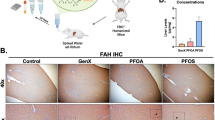Abstract
Increasingly, epidemiological evidences indicate chemosynthetic perfluorooctanoic acid (PFOA), an environmental pollutant, induces potential adverse effect on human health after long-term exposure. However, less study has been performed for assessment of acute effect of PFOA exposure on metabolic homeostasis. In experimental designs, PFOA-exposed liver cells in vivo and in vitro were used to discuss underlying mechanism related to PFOA-induced metabolic dysfunction. In serological tests, PFOA-exposed mice showed increased treads of liver functional enzymes in alanine transaminase (ALT), aspartate transaminase (AST), and total bilirubin (T-BIL), trypsinase, low density lipoprotein-cholesterol (LDL-C), and insulin, while blood glucose, high density lipoprotein-cholesterol (HDL-C), and glucagon levels were reduced. In histocytological observations, PFOA-exposed liver showed visible cytoplasmic vesicles, and intact pancreatic islets were observed in PFOA-exposed pancreas. Additionally, increased insulin-positive cells and reduced glucagon-positive cells were detected in PFOA-exposed islets. As shown in immunoassays, PFOA-exposed liver resulted in elevations of cluster of differentiation 36 (CD36)-labeled cells and CD36 protein. In mouse liver cell study, PFOA-exposed cells showed increased cell apoptotic count, and increased phosphorylated levels of Bcl-2 and Bad in the cells. Furthermore, PFOA-exposed liver cells exhibited elevations of CD36-labeled cells and CD36 protein. Taken together, the present data demonstrate that acute exposure to PFOA-impaired liver function is associated with inducting CD36 expression and apoptosis, as well as disrupting key hormones in the pancreas.




Similar content being viewed by others
References
Abdel-Misih SR, Bloomston M (2010) Liver anatomy. Surg Clin North Am 90:643–653
Das KP, Wood CR, Lin MT, Starkov AA, Lau C, Wallace KB, Corton JC, Abbott BD (2017) Perfluoroalkyl acids-induced liver steatosis: effects on genes controlling lipid homeostasis. Toxicology 378:37–52
Fujitani Y (2017) Transcriptional regulation of pancreas development and β-cell function [review]. Endocr J 64:477–486
Glatz JF, Luiken JJ (2017) From fat to FAT (CD36/SR-B2): understanding the regulation of cellular fatty acid uptake. Biochimie 136:21–26
Guo C, Xie G, Su M, Wu X, Lu X, Wu K, Wei C (2016) Characterization of acetaminophen-induced cytotoxicity in target tissues. Am J Transl Res 8:4440–4445
Jian JM, Guo Y, Zeng L, Liang-Ying L, Lu X, Wang F, Zeng EY (2017) Global distribution of perfluorochemicals (PFCs) in potential human exposure source—a review. Environ Int 108:51–62
Jones BJ, Tan T, Bloom SR (2012) Minireview: glucagon in stress and energy homeostasis. Endocrinology 153:1049–1054
Klaunig JE, Hocevar BA, Kamendulis LM (2012) Mode of action analysis of perfluorooctanoic acid (PFOA) tumorigenicity and human relevance. Reprod Toxicol 33:410–418
Li K, Gao P, Xiang P, Zhang X, Cui X, Ma LQ (2017a) Molecular mechanisms of PFOA-induced toxicity in animals and humans: implications for health risks. Environ Int 99:43–54
Li R, Guo C, Wu X, Huang Z, Chen J (2017b) FGF21 functions as a sensitive biomarker of APAP-treated patients and mice. Oncotarget 8:44440–44446
Li R, Liang L, Wu X, Ma X, Su M (2017c) Valproate acid (VPA)-induced dysmetabolic function in clinical and animal studies. Clin Chim Acta 468:1–4
Sheng N, Li J, Liu H, Zhang A, Dai J (2016) Interaction of perfluoroalkyl acids with human liver fatty acid-binding protein. Arch Toxicol 90:217–227
Sonksen P, Sonksen J (2000) Insulin: understanding its action in health and disease. Br J Anaesth 85:69–79
Su M, Chao G, Liang M, Song J, Wu K (2016) Anticytoproliferative effect of vitamin C on rat hepatic stellate cell. Am J Transl Res 8:2820–2825
Vernon RG (2005) Lipid metabolism during lactation: a review of adipose tissue-liver interactions and the development of fatty liver. J Dairy Res 72:460–469
Funding
This study is granted in part by a funding from National Natural Science Foundation of Guangxi (No. 2016GXNSFBA380055).
Author information
Authors and Affiliations
Corresponding authors
Ethics declarations
Conflict of interest
The authors declare that they have no conflict of interest.
Additional information
Responsible editor: Philippe Garrigues
Rights and permissions
About this article
Cite this article
Wu, X., Liang, M., Yang, Z. et al. Effect of acute exposure to PFOA on mouse liver cells in vivo and in vitro. Environ Sci Pollut Res 24, 24201–24206 (2017). https://doi.org/10.1007/s11356-017-0072-5
Received:
Accepted:
Published:
Issue Date:
DOI: https://doi.org/10.1007/s11356-017-0072-5




